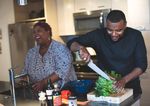How to keep on track with (and track of) your exercise resolution
by Peter Edwards,
- January 25, 2018
- Leave a comment
On the 1st of January, many of us resolved to either eat better, lose weight and/or exercise more. However most people don’t successfully follow through on their resolutions largely because they’re so general and non-specific, with little accountability and intention on tracking progress.
|
Keep on Track! Exercise in particular, is about the long-game. That is, the long-term benefits (lower risk of cancer, heart disease, type 2 diabetes and chronic musculoskeletal injuries) are so powerful and important, that it’s almost a no-brainer. Unfortunately, humans are short-term thinkers and when we don’t perceive the immediate benefits, we lose interest. So how do we keep going? |
 |
|
|
Make your activity enjoyable Adhering to an exercise plan can be hard. Try and aim to find an activity you find enjoyable, that gets you out socialising, allows you to de-stress and / or that allows you to build competence. Exercise that does any of these things is easier to maintain, than exercise done with the goal of improving appearance, or body weight alone. |
Monitor your progress
Traditionally, people tend to measure the effectiveness of their exercise program by using a set of bathroom scales and a tape measure. While there is some merit in using these to assess body composition and weight changes, they don’t fully depict any improvements in fitness.
A good way to assess your fitness and keep accountable, is to time yourself on a brisk walk or run at any given distance you are comfortable with.
If you're starting out for the first time, you will want to determine a baseline measure, and then every fortnight or month, time yourself over the same distance: a lower time generally indicates better aerobic fitness, and a higher time suggests a need for improvement! Use this as motivation to keep up with your program, and to keep improving!
Keep track of how hard you are moving
Generally speaking, the greater the intensity you exercise at, the fitter you will get. But how do you keep track of hard you are exercising? While there are many popular devices which can track your progress exercise intensity (smart phones, watches and heart rate monitors), the most reliable and portable (not to mention inexpensive) method is your breath, known as the Talk Test.
|
Talk level |
Exercise Intensity |
|
You can talk and sing easily, without running out of breath. |
Low intensity |
|
You can maintain a conversation comfortably, but unable to sing any more than a few words without running out of breath. |
Moderate intensity |
|
You can’t say any more than a few words without having to pause to breathe. |
Vigorous intensity |
The Talk Test works on the principle that the harder you exercise, the more oxygen you will need to consume through your nose and mouth, affecting your ability to maintain conversation or sing. So as your exercise intensity increases, the pace of your breath (which correlates with your usage of oxygen) will begin to quicken and deepen, impacting your ability to talk.
Exercising at a moderate to vigorous intensity – in the case of the Talk Test, your inability to maintain conversation – will help develop your ability to use oxygen efficiently benefitting your overall health and fitness. This is a good way to intrinsically keep tabs on how much fitter you are getting during certain tasks – such as, are you less out of breath when walking over a given distance, or when doing a few squats, or even climbing the stairs at the shops!
Set goals
The problem most people get themselves when setting exercise goals, into is by setting goals which are lofty, focus on immediate or short-term outcomes and without any understanding of how to actually exercise (i.e. pacing yourself) and how to do so appropriately. So when starting out, perhaps try initially setting open goals like “see how active you can be” and wade in slowly. After that, focus on beating what you achieved last time (such as your timed walk), and on making incremental improvements rather than lofty goals planned in advance.
You can also focus on discovering ways for becoming more active that suit you, like trying out different times and days when you can make it to the gym, or different pieces of gym equipment, or where you like going for your walk, and who with (if anyone). From there, you can focus on the process of learning how to be active, like learning how to pace yourself if you go for a walk or run, and knowing, by listening and self-regulating your breathing with the Talk Test!




